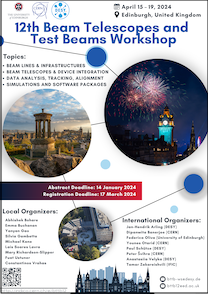Speaker
Description
The Alpha Magnetic Spectrometer (AMS-02) detector operates on the International Space Station. It performs high precision measurements of cosmic ray composition and fluxes, searches for antimatter and dark matter. To increase the detection acceptance and improve its heavy ion identification power, the AMS collaboration plan to add a new layer (L0) of silicon tracker on top of AMS-02. The detector consists of 2 planes, 72 silicon strip detector ladders. Each ladder has 8, 10, or 12 silicon strip detector sensors (SSDs) connected in serial, producing an effective strip length of about 1 meter. The total sensitive area is about $8m^2$.
In order to study the detector ladder in cosmic rays and particle beams, and calibrate the L0 tracker with particle beams before launching to the space, a beam monitor has been produced. The monitor consists of 10 single-SSD modules with a readout electronics system similar to that of the L0 detector. The beam monitor alone had been used in testbeams using electron beam at IHEP to characterize the SSD, which was custom designed for the AMS L0 upgrade. The beam monitor has also been used to test prototype ladders using proton, muon and heavy ion beams at CERN.
In this talk details of the beam monitor and its performance will be described. The tracking and alignment methods based on GBL and Millepede-II packages will also be introduced. Results from the SSD characterization from the testbeam at IHEP will also be presented.
